We’re here to prove to you that setting and managing Magento 2 configurable product inventory is more accessible than you think!
As you know, showing “In Stock” and “Out of Stock” status in your store is very important since it gives your customers informed about the availability of the products.
It is recommended to display product stock status in your Magento 2 store to improve the shopping experience.
However, not everyone knows how to set up Magento 2 configurable product inventory.
So in this article, we will help you get to know all the terminologies and how to bend Magento’s configurable product inventory for your store benefits!
Magento 2 Configurable Product Advanced Inventory
Table of Contents
First, you go to Catalog > Product > Choose your configurable product > Advanced Inventory.

Notably, you can see the Quantity field is 0 and can’t be changed. This is because the Magento 2 configurable product quantity is tracked by the stock of its variables.
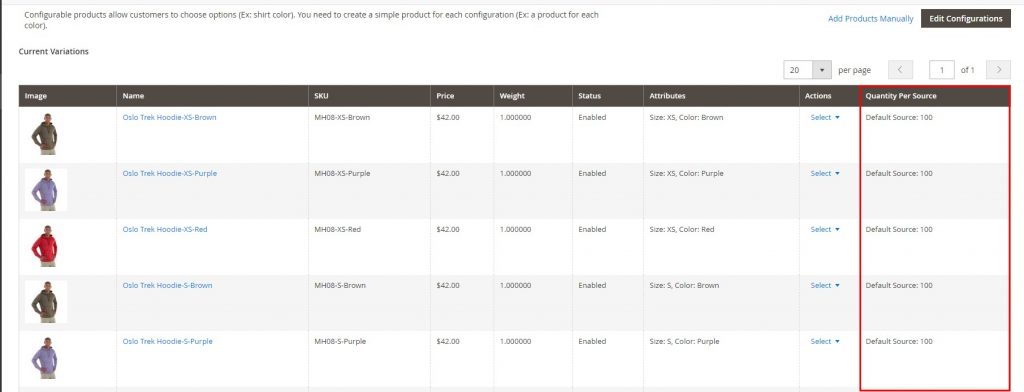
Now, let’s explore every option within the Advanced Inventory of a configurable product and how to configure them probably.
1. Manage stock
The config settings (which you can do by going to Stores > Configuration > Catalog > Inventory) of Manage Stock is always Yes by default.

GET DETAILED RECORD of changes in your stock with Magento 2 Inventory Report extension!
And of course, you want it set to Yes because if this field value was no, the Quantity setting in the backend would have no meaning to your product because you aren’t in charge of Magento 2 configurable product stock status in this case.
2. Out-of-stock threshold
This is an interesting field for Magento 2 configuration product inventory and let me explain why.
The logic for Magento 2 shows out of stock configurable products calls for all child items. This means when all of the variables lower their stock to the number you put in, only then the Out-of-Stock will get displayed.

LEARN how to Enable Stock Alert And Display Out Of Stock Product In Magento 2 HERE!
3. Minimum & maximum quantity allowed in shopping cart
This Magento 2 configurable product stock quantity is equally if not even more fascinating of a configuration option. Either you want to limit your stocking or setting a threshold for customers to cross.
Maximum quantity setting
Let’s start with the maximum quantity allowed in the shopping cart first. I will show you an example and we’ll learn this together.
In the backend of the Oslo Trek Hoodie configurable product, I enter 5 in the Maximum Qty Allowed in Shopping Cart field.

Now, let’s see how it works on the frontend.
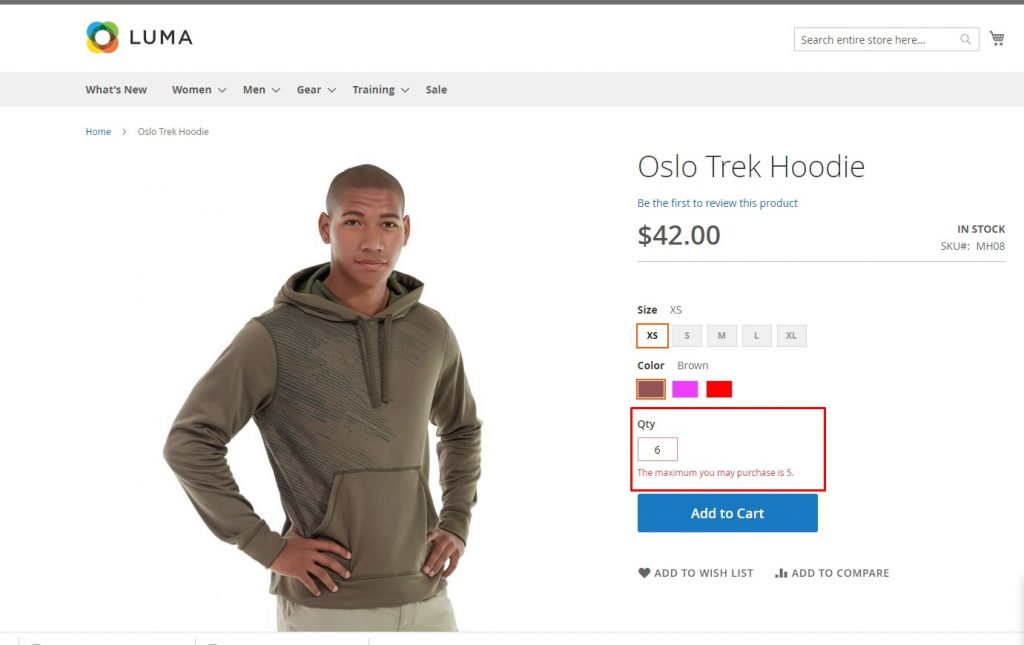
If you enter 6 then the error message will appear that the maximum you may purchase is 5. Like this:
However, you/your customer can buy more than 5 of the same child product by adding to the cart for more than 1 time. Here is how I do it:
First, I add to cart 5 of the XS-Brown version. Then I add to cart one more time with the Qty of 1 of the same child product.
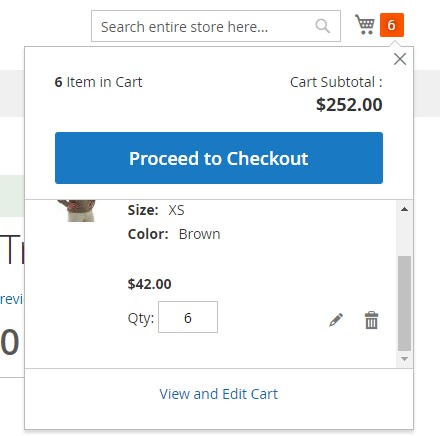
So why does this happen?
It is because we set this for the configurable product – not the variables. Going back to when we talked about quantity earlier, we can’t set a number to the quantity of a configurable product because its quantity is determined by the child products’ stock number.
That’s why if you want to set a maximum quantity allowed in the cart, you need to do it at the variables.
Minimum quantity setting
Now, we’ll talk about the Minimum Quantity Allowed In Shopping Cart. So why do you want to set it in the first place?
There are two main reasons. The first one is due to the characteristic of the product itself. For example, tiles – you hardly know any online store that allows buying and proceed to ship only one of them.

However, the most common reason for setting a minimum amount for a single order is to increase order volume. Hence, the order value will rise accordingly.
However, a fatal drawback of the default Magento 2 configurable product stock quantity setting is the lack of customer group specification.
You can only configure down to the customer group by going to Stores > Settings > Configuration > Catalog > Inventory. However, this rule will apply for the whole catalog but not the specific product.
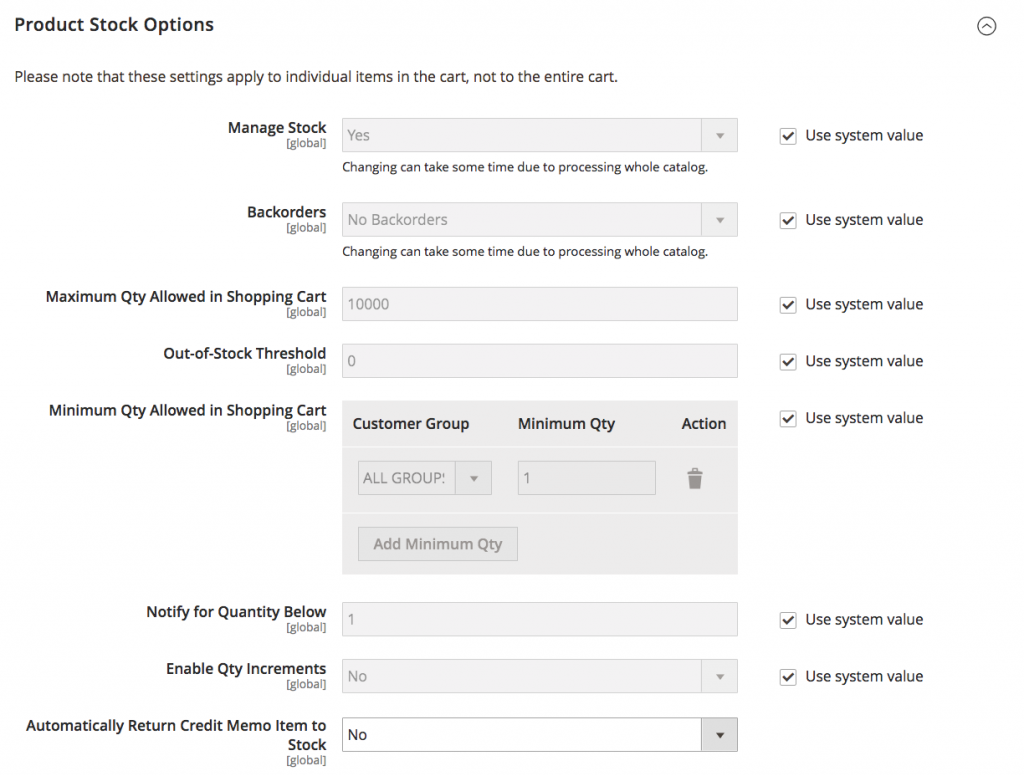
4. Quantity uses decimal

This configuration is really helpful when you operate on products that sell by weight, length, or volume. For example, fabric.
This way, your customer can enter a decimal amount instead of a whole number for the order to proceed. And this one is quite simple, all you need to do is turn it to Yes.
5. Allow multiple boxes for shipping
The name of this field is pretty much self-explanatory.

If the order volume is high or your product can get divided into different parts, you might want to ship the order in multiple boxes. In that case, turn on this configuration.
6. Magento 2 backorders
Basically, you allow customers to order a product that is out-of-stock (Magento’s guideline recommends to set the Out-of-Stock threshold to a negative number). The order will ship when the product is available.

– No Backorders: you don’t allow Magento 2 backorders when the product is out of stock.
– Allow Quantity Below 0: when the quantity is below 0, your customers can still order.
– Allow Quantity Below 0 and Notify Customer: Accept Magento 2 backorders when the quantity falls below zero, but notifies customers that orders can still be placed.
7. Notify for quantity below
When the stock level falls below the number set in this box, a notification will be sent to you.

It’s a good idea to keep your eye on stocking status all the time, especially when you have a handful of products to care for.
8. Enable qty increments
To sell the product in quantity increments, please select Yes.

Quantity Increment is known as selling with an increase on an incremental scale. For instance, if you set to 5 in Quantity Increments field, customers must order a quantity of 5, 10, 15, and so on. Besides, if they try to purchase in any other quantity, there will be a notification message showing up.
If you don’t want to sell your items as an increment, then choose No.
9. Stock status
You have two options for Magento 2 configurable product stock status: In Stock or Out-of-Stock.
When switching to Out-of-Stock, no matter what number you set for the quantity earlier – it will get an Out-of-Stock treatment.
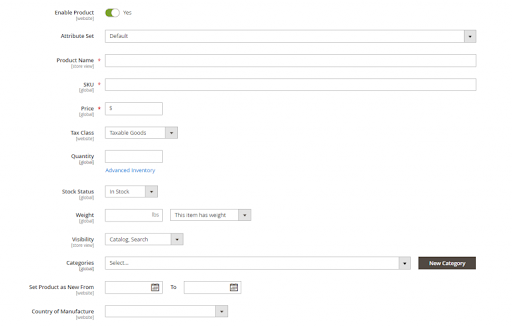
The Logic Of Configuration Fallback And Inheritance
So here are the inheritance tree in which configuration at each step override others:
Product Source > Advanced Options > Global Inventory store configuration.

Therefore, when Magento scan for custom configuration to apply, this order will proceed:
- Magento checks for custom settings at the Product level in the Sources area. A couple of settings are accessible.
- Magento then checks the Product Advanced Inventory settings.
- When Config Settings is chosen for the item settings, it checks for an incentive in the Stores > Configuration > Inventory page.
For instance, you may design delay purchases diversely over your store. You may have delay purchases arranged as follows:
- Globally: Allow backorders for the store, set Out-of-Stock Threshold to -50
- Product: Block backorders for a specific product, set Out-of-Stock Threshold to 10
Assigning Magento Source And Stock For Configurable Product On The Editing Page Itself
In the editing page of the configurable product of choice, you scroll down to the Configurations and tap on the Edit Configurations button:
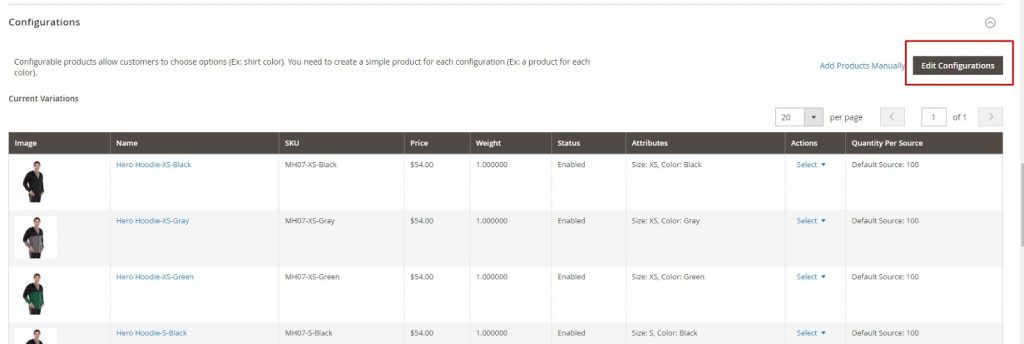
Then, click Next until you get to Step 3: Bulk Images, Price, and Quantity.

From here, there are two ways you can go and set up your quantity and source.
Apply single quantity to each SKUs
After selecting this option, click on Assign Sources.

Here, pick and choose the source you want for this product and click Done when you’re finished.
After that, you enter the Magento 2 configurable product quantity for the according to the source.
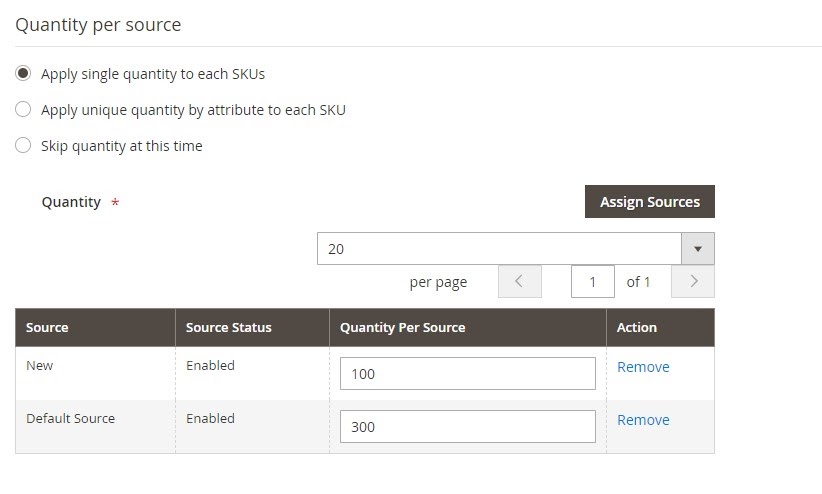
Apply unique quantity by attribute to each SKU
Click on this option then choose the attribute you want to set quantity for.
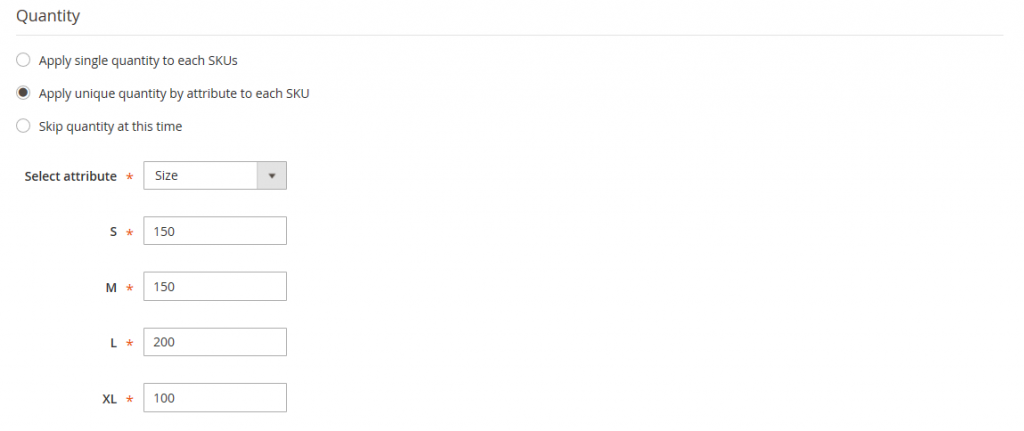
When finished, you want to proceed to Next and then Save.
Setting Magento Source And Stock For Configurable Product Through Its Child Associates
Magento source management
To be able to understand more about Magento 2 configurable product inventory, we must talk about this first.
Definition
Sources are the physical areas where item stock is overseen and sent for request satisfaction, or where administrations are accessible.
These areas can incorporate stockrooms, physical stores, dissemination focuses, and drop shippers. You dispense stock amounts to these sources, and Magento naturally totals the all-out attractive items for your stocks.

For huge organizations, include various hotspots for the entirety of your areas: in various geographic areas by nation and landmass, areas in a city, in light of the sort of stock, even dependent on administrations.
The fixture nature of Magento Source
Every Magento store starts with a mandatory Default Source that is free to update but not disable. There are three main areas of source that you can customize:
- Location Information – Each source incorporates the name, nation, physical location of the area, and a state of contact.
- Enabling Resources – You can empower and impair sources varying. Possibly empower a source in the event that it acknowledges and satisfies requests and delays purchases.
- Available Inventory – Dole out and update stock amounts for each source through the item page. The stock amounts are determined, given, and saved through the source and stock planning.
Magento provides an example of defining sources for a bicycle shop selling a mountain bike:

All stores begin with a Default Source that must remain enabled:
- All new products imported into Magento require a source and stock, automatically assigned for immediate access to inventory management.
- Single Source merchants use the Default Source as their single point of inventory location and shipments.
Setting for Magento Multi-source Inventory
My fellow colleague has written a detailed and informative article on setting for Magento source management as well as all the way you can make it better.
Magento 2 configurable product stock availability configuration
The next step after configuring the Magento source is Magento stock. Again, this also needs to be done at the variables of the configurable product.
Definition
Stock is a virtual Magento 2 configurable product inventory that counts for every source of your sale channel (in ecommerce – correctly Magento, website.).
Accordingly, one stock can be assigned for several websites, while one website can only have one stock.
- Sales Channel Support – This feature is almost exclusively for the website. However, you can extend sales channels to include custom options like B2B customer groups and store views.
- Map to Sources – Each stock can have one or more enabled or disabled sources assigned, calculating the virtual inventory per product.
- Priority Order Fulfillment – This one is an algorithm that prioritizes stock’s source when fulfilling orders.
Let’s exam this diagram on the relation amongst Stocks, Sources, and Websites:
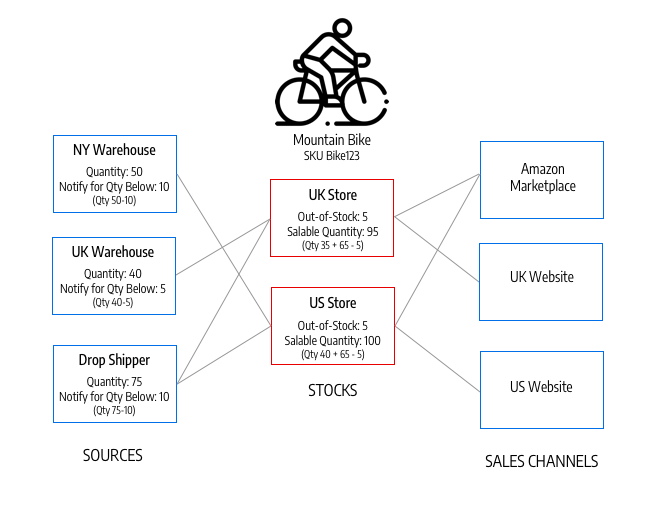
Here we can see that both Amazon Marketplace and UK websites share the same UK Stock. This stock is the combination of the Drop Shipper source and the UK warehouse.
On the contrary, the US website uses the US stock that comes from the Drop Shipper source and the NY warehouse.
Setting for Magento Stock Inventory
- Navigate to Stores > Inventory > Stock.
- Click Add New Stock.
- Expand the General section and enter a Name for your new stock.

4. Open up the Sales Channels section and click on Websites. If you want to choose multiple options, hold down the Ctrl key (PC) or the Command key (Mac) and click each website.
Two things to remember: a. Any website that is not assigned a Stock will fall under the Default Stock; b. If you choose a website that previously belongs to another stock, it said the website would be unassigned from that stock.

5. Open the drop-down Sources section, and if not the default stock, click Assign Sources.

-
- Choose all the sources you want your stock to include.

-
- Click Done.
6. Organize the priority of source with simple drag n’ drop motion. This order is critical to the shipping stage of the order.
7. On the Save menu, choose Save & Close.
Managing inventory quantities
Before setting the Magento 2 configurable product quantity for a product, you need to give it a source.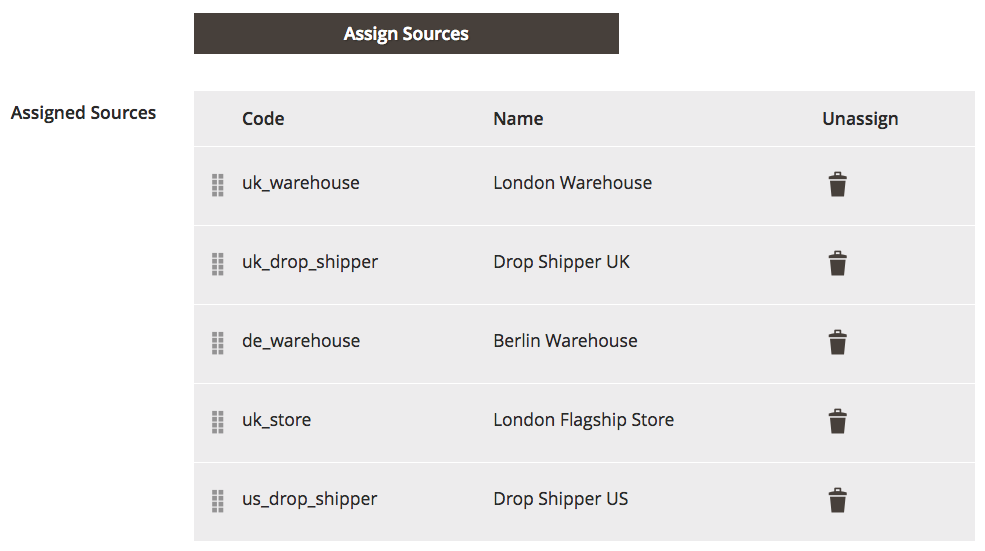
Once you take the source out of the product, the quantity will get cleared out. And even if you reassign the source, there are rooms for errors at quantity for sales, keeping stock, and processing order.
That’s why you want to edit the source of a product after your orders get out of the door. To do exactly this, in the Magento Backend, go to Catalog > Product.
Here, you open the product of choice and further expand the Source section.
Assign source for product

After that, click on the Assign Source button and start adding your source as wanted.

When you’re finished, click on the Done button then Save.
Update quantity for the product
After choosing all the sources you want for that product, enter the Quantity for each of the sources.

The Notify Quantity is similar to the one at the Advanced Inventory setting. You either use the global default setting or customer the number by filling in your own.
After that, click Save to set this in stone.
Mass assign/unassign source
You can imagine the pain of editing inventory for every product one-by-one. Luckily, Magento does support a function that helps you do it in bulk.
Here is how we do it.
In the Product grid, tick on the 1st field of the products you want to assign source.
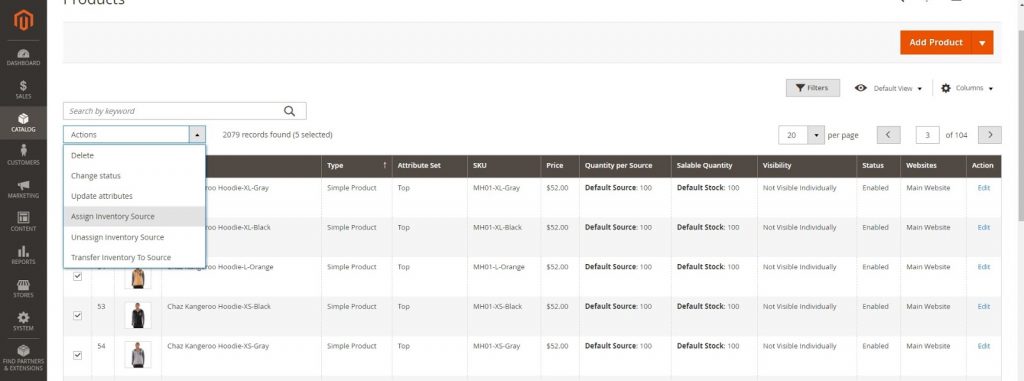
Then, you click on the Action > Assign Inventory Source. Here, choose the source you want to apply for those products and tap on Assign Source to save.

To unassign source in bulk, you do the same except click on the Unassign Inventory Source in the Action field.
Tick on the source you no longer want to apply for those products then continue to click on Unassign sources to save.
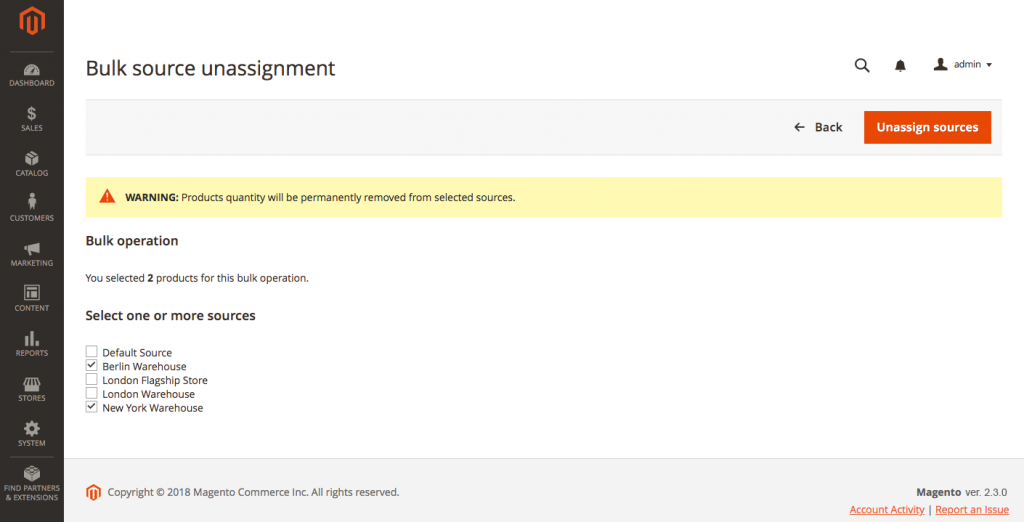
Transfer inventory to source
This case is when you’re closing down a certain stocking location or just simply want to change the source to another one.
You’re going to choose all the products you want to change as previously only to click Transfer Inventory To Source in the Action bar.
Here you pick and choose the original source and what’s the new one.
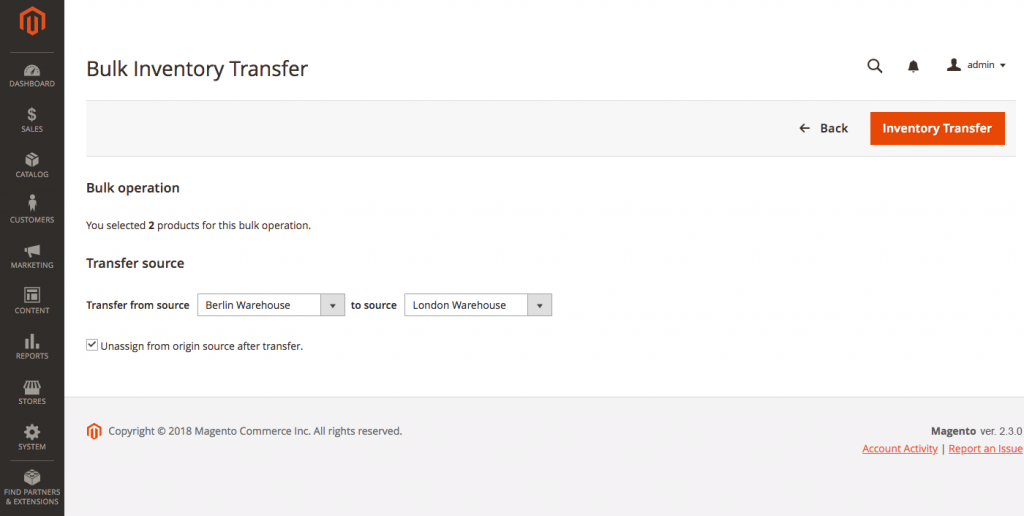
To deduct the original source after the transfer, tick on Unassign from origin source after transfer. After that, you’re free to tap on Inventory Transfer to save.
Import/export source
When you have thousands of products waiting for source editing, the more relaxed and logical way to go is import/export source.
All you need is a CSV file. The source_code refers to the code name of your source. The SKU is the SKU of your product in Magento (remember, it needs to be matched).

The value for status is 0 for Out-of-Stock and 1 for In-Stock. Last but not least, you have quantity collum, which is the quantity of the product for that particular source.
You can quickly fact check these values by exporting your own Magento 2 configurable product inventory. Go to System > Data Transfer > Export. Choose Stock Sources in the Entity Type. Then proceed to continue.

You can also export products in a particular source by choosing the code name in the Entity Attribute grid.

And then click on Continue.
After preparing your CSV file, go back to the Data Transfer sector, and choose Import.

Choose Stock Source for Entity Type. Then proceed to choose the Import Behavior. Next, upload your CSV file and click on Check Data to complete the job.
Wrap Up
We’ve learned everything about Magento 2 configurable product inventory, from the definition, it’s natures, and how to set up.
Hopefully, this article can help you flatten the learning curve with managing configurable products in Magento.
If you need any further help, don’t worry, we’re on 24/7 support, always!
EXPLORE NOW why Magento 2 Out Of Stock Notification Extension is a must!
BSS Commerce is one of the leading Magento extension providers and web development services in the world. With experienced and certified Magento developers, we commit to bringing high-quality products and services to optimize your business effectively. Furthermore, we offer FREE Installation – FREE 1-year Support and FREE Lifetime Update for every Magento extension.
CONTACT NOW to let us know your problems. We are willing to support you every time.
